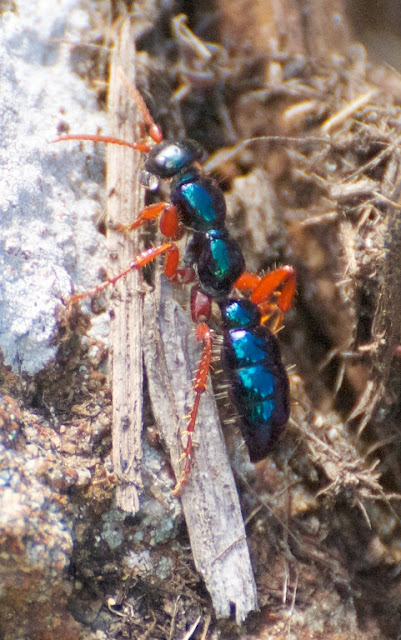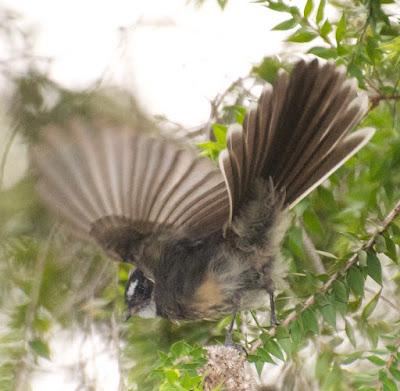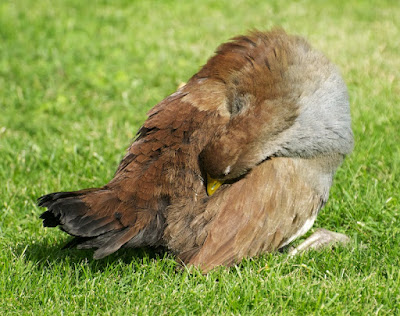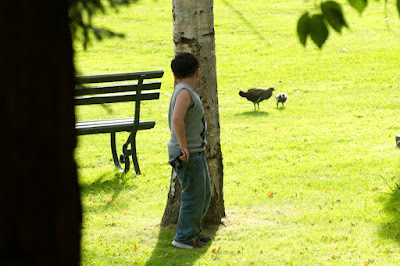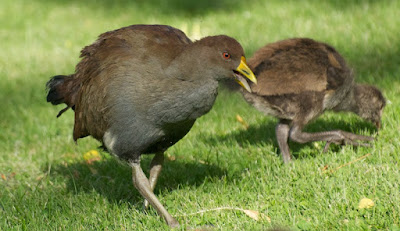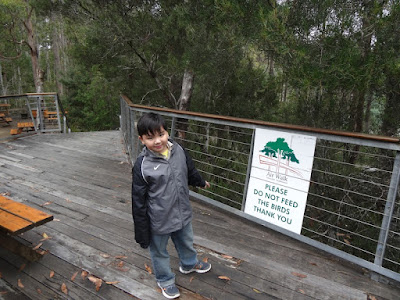Sunday, November 29, 2015
Australia: Blue Ants and Flightless Rails
The Royal Tasmanian Botanical Gardens, not far from the centre of Hobart, occupied much of our second full day in Tasmania (March 19, 2015). It's an excellently-planned, well laid out and attractive area (it was founded almost 200 years ago, in 1818). As Ryan demonstrates here, it is a very good place to take your children (or, in our case, grandchildren).
We ended up visiting the gardens twice that day, bookending visits to some less natural spots (such as the Cadbury chocolate factory). In the morning, we spent much of our time simply strolling, enjoying the numerous pathways...
...or looking out over the attractively-planted ponds.
I was particularly fascinated by a unique indoor exhibit: a Sub-Antarctic Plant House devoted to the windswept islands of the Australian "Roaring Forties". Though small, it has been painted, designed and climate-controlled to give a very good feeling of a visit to the cold and misty slopes of Macquarie Island, 1500 kilometres away to the southeast.
Here is one of its featured plants: Macquarie Island Cabbage (Stilbocarpa polaris), a member if hte ivy family (Araliaceae) that visiting seal hunters and explorers used for food (and as a source of Vitamin C).
Back outside I found a Meadow Argus (Junonia villida), one of only thirty-nine butterflies found in Tasmania. I is a a wide-ranging species, found as far north as Java and Fiji.
Ryan was the first to notice this rather startling insect. It is known as a Blue Ant (Diamma bicolor), but it is actually the wingless female of a wasp (Family Tiphiidae). It can prove its identity, should one be so foolish as to doubt it, by delivering a powerful sting.
The gardens are a good place to see some of the commoner local birds, and Ryan was eager to help me find them. Though the Laughing Kookaburra (Dacelo novaeguineae) is quintessentially Australian, it is not native to Tasmania. Kookaburras were introduced here in 1905, and have done better here than in some parts of their native range n(ot to mention becoming a serious predator on the island's native reptiles).
Australia's Grey Fantail (Rhipidura albiscapa) was long included with the fantails of New Zealand, but is now regarded as a separate species. It is mostly a winter visitor to Tasmania, but a few
(perhaps including this engaging individual) remain all year.
Fantails delight me, mostly because of their endless dance through the bushes as they spread and flounce their tail feathers - not a courtship or a territorial display, as you might think, but a means of flushing out insect prey. For North American birders who have never met a fantail, think of a more exaggerated version of tan American Redstart (Setophaga ruticilla), whose posturing is done for much the same reason, as are similar dances by a number of other flycatching birds in various parts of the world.
The Scarlet Robin (Petroica boodang) is a member of the particularly Australasian family Petroicidae. There are a number of species of Petroica in Australia, but the Scarlet is the only one whose female (as here) retains some of the male's bright breast colour. Scarlet Robins are common in Tasmania, and we will meet the male in a later posting.
The tiny and engaging pardalotes were once thought to be a sort of flowerpecker, but they are placed today in a family of their own, the Pardalotidae. Most Australian songbirds, like marsupials, belong to uniquely Australasian families that radiated on the continent into forms that resembled birds of other lands: flycatchers, babblers, thrushes and the like. Pardalotes are no exception; they are most closely related to the so-called Australian 'warblers' (Acanthizidae). There are only four species; this is a female Spotted Pardalote (Pardalotus punctatus), a common bird with a song that sounds like the 'two-bits' response to 'shave and a haircut'. On my first trip to Tasmania I encountered its much rarer, endemic cousin the endangered Forty-spotted Pardalote (P. quadragintus), but I was not destined to see it this time around.
The dominant songbird family in Australia is the Meliphagidae, the honeyeaters. The Eastern Spinebill (Acanthorhynchus tenuirostris) is a favourite of mine, and one of the prettiest of the lot. It is a lot easier to see than its cousin the Western Spinebill (A. superciliosus), a bird that eluded me until literally the last hours of our trip to Western Australia in 2013.
The Little Wattlebird (Anthochaera chrysoptera), despite its name, is one of the larger honeyeaters. Tasmania is home to the largest of the lot, the Yellow Wattlebird (A. paradoxa), a bird that I saw but was, unfortunately, unable to photograph.
The garden ponds were home to some very Pacific Black Ducks (Anas superciiosa) (and their ducklings)...
...and provided drinking water for another introduced bird, the European Goldfinch (Carduelis carduelis).
On our morning visit we ran into a few people who noticed that we were interested in birds, and kept telling us about the "native chickens" that ran about the area in the late afternoon. There was only one bird they could be referring to, and we headed back to the gardens near the end of the day to see it.
This was, of course, the Tasmanian Native-Hen (Tribonyx mortierii), probably the most successful flightless rail left in the world.
Like the Tasmanian Devil and the Thylacine, the two large mammals inextricably associated with the island state, the Native-Hen once lived on the Australian mainland (where its smaller, flying relative, the Black-tailed Native Hen (T. ventralis), still thrives). It survived there until at lest 4,670 years ago, the date of its most recent radiocarbon-dated remains, but soon afterwards fell prey either to human hunters or to the recently-arrived Dingo.
Flightless rails of many species were once common, or even abundant, on predator-free islands around the world, but they were often among the first victims to disappear after humans arrived. Today only a few remain, mostly in remote places like the well-named Inaccessible Island in the Atlantic. The Weka (Gallirallus australis) is still common, though beleaguered, in parts of New Zealand, and on tiny Lord Howe in the Tasman Sea the Woodhen (G. sylvestris) has staged a remarkable, if limited, recovery from a low of thirty birds in the 1970s to over 200 today. Surely, though, Tasmania must be the only place (except, perhaps, for the settlement on Lord Howe, and perhaps some bits of Weka habitat in New Zealand) where you can watch flightless rails scurrying about unconcernedly in what is, essentially, a city park.
In other words, watching these large, dumpy creatures is not only an experience in itself, but a reminder that even some of the most vulnerable creatures on the planet can, if the conditions are right, survive in our midst. Besides, they gave Ryan a great opportunity to practice his nature photography.
We had a good time watching them, especially in a place where they were tame, even bold, and Eileen could relax on a sunny park bench while Ryan and I went native-henning.
Notice the rather loose plumage on this preening bird. I can't say how this compares to the feathers of the Native-Hen's flighted cousins, but loose plumage is common in flightless birds (which have no need to be aerodynamic, or to reduce drag).
Native-Hens are surprisingly prolific, and can produce up to ten young in good years (a valuable talent, as a lot of them fall prey to predators - though perhaps less so in the gardens). Ryan was very careful to approach families with a proper degree of caution.
I'd like to say something here about protective mothers guarding their children, but given the life history of the Tasmanian Native-Hen I'm not at all certain that this is what we are seeing. The Tasmanian Parks and Wildlife Service (see link above) points out that "The social structure of Native Hens is unique. Research has shown that within a population of native hens, roughly half are monogamous (have only one mate) and half polygamous (have more than one mate). Polygamy in Native Hens most often occurs in groups of 3 - 5 individuals of which only one is female. This female actually mates with all other males in the group, a behaviour called polyandry. In addition, juvenile Native Hens assist with the raising and protection of their brothers and sisters."
So the adult accompanying these chicks could be their mother, father, step-uncle or older sibling.The chicks don't seem to mind.
The main thing is that they are there, running about on the lawn of the gardens with long, strong legs, carrying on their species with aplomb, and having no need, ever, to fly.
Labels:
Australia
Thursday, November 26, 2015
Australia: Off to Tasmania
The morning of March 18, 2014, found Eileen, Ryan and I looking down from the viewing platform on the heights of Mount Wellington. I was last here forty years earlier, in 1974, and I still think it is the best way to start a visit to Tasmania.
Below us, in the mist, lay the city of Hobart and the estuary of the Derwent River - still a fine view, even on a damp and foggy day.
Behind us stood the Pinnacle, an impressive pile of rocks, 1270 metres above the Tasman Sea.
Was there a drawback? Well, yes; it was cold up there. The winds bit at us - we were, obviously, a long way from Malaysia!
The combination of cold and wind create ideal conditions for the growth of alpine heathland and low scrub, the plant community that covers much of the summit. Tasmania has a fascinating flora, with over 500 species found nowhere else. A good many of them grow in the vicinity of the mountain.
Fire has altered the plant composition on the summit. It has eliminated some sensitive species, but has benefited Kerosene Bush (Ozothamnus ledifolius), a composite which now the dominant plant in the alpine scrub.
March is well outside the flowering season in Tasmania, but there were still a few things in bloom. This appears to be Common Fireweed or Fire Groundsel (Senecio linearifolius), a widespread southeastern Australian species and a common roadside plant in Tasmania.
Numerous lichens, some quite attractive, grew on bare rocks that thrust above the scrub.
Finally, the cold got the better of us. We started on our way down, dropping below the treeline and driving through the forest that covers the lower slopes of the mountain.
We devoted the rest of the day to an excursion south of Hobart, with our eventual goal being the forests of the Huon Valley. Our route took us through Tasmania's apple-growing country, and along the long, narrow estuary of the Huon River, dotted with sailboats, before we turned west along Arve Road towards the upper reaches of the Huon and the famous, and much-publicized, Tahune Airwalk.
The plant life here could not have been more different from the treeless slopes of Mount Wellington. This is the land of the Mountain Ash (Eucalyptus regnans), the tallest flowering tree in the world and a rival for the tallest of all trees, the redwoods of California.
The Huon Valley, however, is not pristine forest. The trees have been logged, and I was disappointed in my hope to show Ryan something akin to the giants I had seen near Lake Pedder, in Tasmania's far southwest, back in 1974. Besides, the track to the biggest tree in the valley was, alas, closed (though we could glimpse it from the car).
Mind you, these were still pretty big trees.
Besides, it was raining once we reached the bridge over the Huon River that leads to the Airwalk. We decided, therefore, to forgo paying the rather hefty fee for the privilege of slipping about on an elevated, rain-soaked steel walkway. Instead, Eileen decided to relax in the car while Ryan and I poked around a bit (for free) at ground level.
Here, at least, I could photograph the almost shockingly purple berries of Tasmanian Flax Lily (Dianella tasmanica)...
...and get on close terms with a Black Currawong (Strepera fuliginosa) perched on the sign at the Airwalk entrance. This is one of the more approachable of the eleven bird species endemic to Tasmania, where it replaces the widespread Pied Currawong (S. graculina) of the mainland.
It presumably expected a handout from us; obviously it was incapable of reading this sign (or it could read it, but hoped that human visitors to the area would include some generous illiterates).
With that, we headed back to Hobart. As we drove up the estuary again the clouds cleared, and a rainbow promised us (despite Tasmania's reputation for dampness) better weather to come.
Below us, in the mist, lay the city of Hobart and the estuary of the Derwent River - still a fine view, even on a damp and foggy day.
Behind us stood the Pinnacle, an impressive pile of rocks, 1270 metres above the Tasman Sea.
Was there a drawback? Well, yes; it was cold up there. The winds bit at us - we were, obviously, a long way from Malaysia!
The combination of cold and wind create ideal conditions for the growth of alpine heathland and low scrub, the plant community that covers much of the summit. Tasmania has a fascinating flora, with over 500 species found nowhere else. A good many of them grow in the vicinity of the mountain.
Fire has altered the plant composition on the summit. It has eliminated some sensitive species, but has benefited Kerosene Bush (Ozothamnus ledifolius), a composite which now the dominant plant in the alpine scrub.
March is well outside the flowering season in Tasmania, but there were still a few things in bloom. This appears to be Common Fireweed or Fire Groundsel (Senecio linearifolius), a widespread southeastern Australian species and a common roadside plant in Tasmania.
Numerous lichens, some quite attractive, grew on bare rocks that thrust above the scrub.
Finally, the cold got the better of us. We started on our way down, dropping below the treeline and driving through the forest that covers the lower slopes of the mountain.
We devoted the rest of the day to an excursion south of Hobart, with our eventual goal being the forests of the Huon Valley. Our route took us through Tasmania's apple-growing country, and along the long, narrow estuary of the Huon River, dotted with sailboats, before we turned west along Arve Road towards the upper reaches of the Huon and the famous, and much-publicized, Tahune Airwalk.
The plant life here could not have been more different from the treeless slopes of Mount Wellington. This is the land of the Mountain Ash (Eucalyptus regnans), the tallest flowering tree in the world and a rival for the tallest of all trees, the redwoods of California.
The Huon Valley, however, is not pristine forest. The trees have been logged, and I was disappointed in my hope to show Ryan something akin to the giants I had seen near Lake Pedder, in Tasmania's far southwest, back in 1974. Besides, the track to the biggest tree in the valley was, alas, closed (though we could glimpse it from the car).
Mind you, these were still pretty big trees.
Besides, it was raining once we reached the bridge over the Huon River that leads to the Airwalk. We decided, therefore, to forgo paying the rather hefty fee for the privilege of slipping about on an elevated, rain-soaked steel walkway. Instead, Eileen decided to relax in the car while Ryan and I poked around a bit (for free) at ground level.
Here, at least, I could photograph the almost shockingly purple berries of Tasmanian Flax Lily (Dianella tasmanica)...
...and get on close terms with a Black Currawong (Strepera fuliginosa) perched on the sign at the Airwalk entrance. This is one of the more approachable of the eleven bird species endemic to Tasmania, where it replaces the widespread Pied Currawong (S. graculina) of the mainland.
It presumably expected a handout from us; obviously it was incapable of reading this sign (or it could read it, but hoped that human visitors to the area would include some generous illiterates).
With that, we headed back to Hobart. As we drove up the estuary again the clouds cleared, and a rainbow promised us (despite Tasmania's reputation for dampness) better weather to come.
Labels:
Australia
Location:
Hobart TAS, Australia
Subscribe to:
Comments (Atom)









